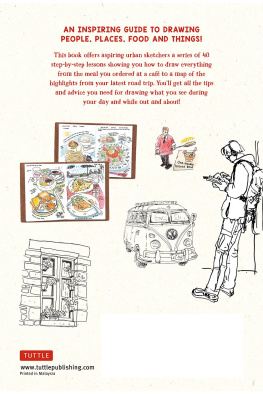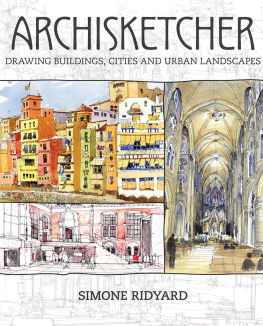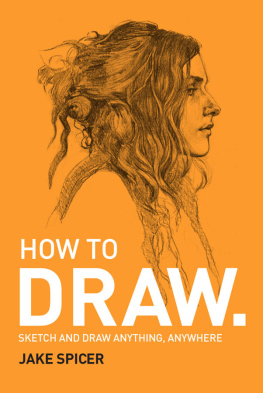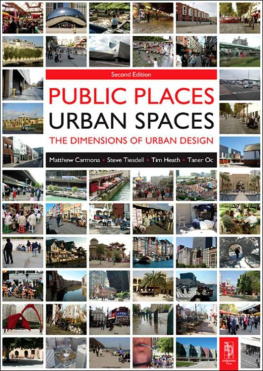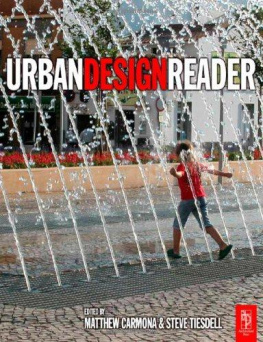

Contents
HOW TO USE THIS EBOOK
Select one of the chapters from the and you will be taken straight to that chapter.
Look out for linked text (which is in violet) throughout the ebook that you can select to help you navigate between related sections.
INTRODUCTION
This book is for anyone with an interest in the visual character of the cities and buildings that frame our lives. It is intended to help you capture the life of the places where we work and spend our free time, and of the places we visit in our travels both near and far. The skills and strategies presented here will help you make a visual record of the urban places you experience, and help you learn about these places in the process.
Cities and Buildings
Cities, large and small, are a physical manifestation of the ways we organize ourselves as societies. They dont always work the way we would like, and they can remind us of our less effective attempts at planning and development. Nonetheless, cities bring together humankind in all its wonderful diversity; they act as an impetus for the arts, and are magnets for commerce and the leisure time that accompanies economic development.
Cities concentrate some of our most exalted achievements in architecture and planning, and their museums, theaters, restaurants, parks, and so on, are the venues for our cultural identity and advancement. Our cities express our ideals and aspirations as societies, and are the places where we determine who we are and how we create our successes in life. As such, cities are always worth our careful analysis and consideration. Drawing is one of the most direct and effective means by which we can achieve this essential and ongoing study.

Why Draw?
At least since the dawn of recorded history, drawing has been an essential form of expression. While digital technology has recently been distracting us somewhat from engaging in authentic, handmade arts and crafts, the computer will never fully replace the connections that occur between eyes, mind, and hand in the act of drawing from observation. We may also draw because its an enjoyable thing to do. Drawing can be relaxing, as when we doodle mindlessly to pass the time, or it can be a great challenge, as when we attempt to draw what we see with a high degree of accuracy. This book is not about trying to create picture-perfect images, but it is about drawing what we see rather than merely doodling or drawing from the imagination. Drawing from observation is primarily about studying the things we see in the world, and only secondarily about producing polished works.
Certainly, the end products of our effortsthe finished drawingscan sometimes stand on their own as valuable works of art. To produce such works is often a motivating factor in attracting people to the practice of drawing in the first place. But most often, in the process of learning to draw we begin to sense that drawing is valuable because it forces us to really look at our surroundings, to spend time considering the way things are in our environment, and ultimately to understand the world around us more deeply than we would have without drawing. With this type of study as the goal, the drawings themselvestheir quality or completenessare often less important than the learning they represent.
For this reason, most artists draw in sketchbooks, with no intention to hang individual drawings on the wall, and the sketchbook becomes a storehouse of experience and memories regarding places visited, observed, and studied. With instruction and practice, the artist will see improvement in the quality of their drawings, and also in their ability to complete drawings in a relatively brief span of time. Such improvement ultimately makes drawing an ever more accessible and enjoyable way to learn about the world around us.
Time and Drawing
The ability to draw well is a skill that requires learning and practice. While we all seem to have an innate ability to be expressive with our hands, no one is born with the ability to draw with great skill. People who have an apparent talent for drawing are those who have invested the time and effort to build their skills for seeing and drawing well.
Some individuals are certainly more motivated than others to develop their skills, and these people are far more likely to make speedy progress. But everyone must go through the time and repeated effort to develop their abilities to the degree they desire.
Learning to draw takes time, of course, and in the process of learning it will often be necessary to spend more than 15 minutes on a single drawing. Practice sessions might last 45 minutes or one houras long as you feel youre being productive, and not becoming frustrated by the experience, feel free to keep practicing. The ability to capture an urban scene or a particular building in 15 minutes should be seen as one goal among many with regard to drawing.
We might feel that not having enough time to complete a drawing will be frustrating, and sometimes thats true. But, though it may seem a paradox, working within small windows of time is actually a good way to combat frustration. Brief drawings help us to stay focused on repeated, short bursts of practice rather than elaborately developed drawings that require far more time without necessarily producing better results. This idea is explored further in the section on Time, Scope, Size, and Medium later in the book. For now it will be helpful to understand 15 minutes as a valuable practice technique and as a potential goal for creating lively, energetic drawings down the line.
Drawing in Public
If our drawing subjects are buildings and cities, then its most likely that well be doing our work outside and in public. A great many artists do their work indoors, in a private and protected studio. Theres an obvious sense of security that comes with such a situation, and we might feel a bit exposed when were actually out and in front of others. But drawing in public involves you directly with your subjectsnot only the sights, but also the sounds, aromas, and other sensations that contribute to a fuller and more memorable drawing experience.
It makes sense to blend in as much as possible and avoid making a show of what youre doing, if only to allow yourself the freedom to focus on your task. But do try to be open to others on the street who might be interested in your drawings, and dont be shy about sharing your sketchbook with them.

Materials
Any type of paper and any type of common writing instrument is all you truly need to begin drawing. When you are just starting to learn, the most important thing to do is simply to draw as often as possible. Regular practice is far more valuable than spending time worrying you dont have the right materials. In other words, the right materials are those that are most immediately available to you, provided youre using them to draw often.
As you begin to develop your drawing skills, its a good idea to experiment with a variety of materials and take notes along the way. Become your own judge of drawing instruments and papers, and try to find combinations that you find comfortable and that give you the results youre after. With time and testing, youll begin to care more about the tools and paper you use, but again, the most important thing to do throughout this process is practice.
Next page

